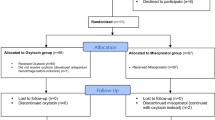Abstract
The aim of this study was to evaluate differences in clinical and laboratory parameters and differences in the complication rates between pre-eclamptic primiparous and pre-eclamptic multiparous women. A prospective case series of 112 primiparous and 186 multiparous women with pre-eclampsia was conducted at Princess Badea Teaching Hospital; a large tertiary public health service hospital in Irbid, North Jordan. A uniform medical and surgical management protocol was implemented. The main outcome measures included antenatal, intrapartum and puerperal, maternal and foetal complications. Multiple maternal and foetal demographic, clinical and laboratory parameters were studied. As expected, the primiparous were younger than the multiparous women. After adjusting for maternal age, regression analysis revealed no difference in the systolic or diastolic blood pressure in the two groups. It was also demonstrated that there was no statistically significant difference in the clinical presentation, haematological and biochemical parameters or ultimate maternal outcome between the two groups. After adjusting for babies’ sex and gestational age, it was demonstrated that there was no statistically significant difference in the following: gestational age at delivery, foetal weight, stillbirth, admission rate to neonatal intensive care unit, neonatal death rate within the first four weeks after birth and incidence of intrauterine growth restriction between the two groups
Similar content being viewed by others
References
Arngrimsson R, Bjornsson S, Geirsson RT, Bjornsson H, Walker JJ, Snaedal G (1990) Genetic and familial predisposition to eclampsia and pre-eclampsia in a defined population. Br J Obstet Gynaecol 97:762–769
Barden AE, Beilin LJ, Ritchie J, Walters BN, Graham D, Mitchael CA (1999) Is proteinuric pre-eclampsia a different disease in primigravida and multigravida? Clin Sci 97:475–483
Brenner WE, Edelman DA, Hendricks CH (1976) A standard of fetal growth for the United States of America. Am J Obstet Gynecol 126:555–564
Brown MA, Buddle ML (1996) Hypertension in pregnancy: maternal and fetal outcomes according to laboratory and clinical features. Med J Aust 165:360–365
Chesley LC (1977) The remote prognosis of eclamptic women. Am Heart J 93:407–408
Chesley LC (1980) Hypertension in pregnancy: definitions, familial factor, and remote prognosis. Kidney Int 18:234–240
Chesley LC (1984) History and epidemiology of pre-eclampsia- eclampsia. Clin Obstet Gynecol 27:801–820
Chesley LC (1985) Diagnosis of pre-eclampsia. Obstet Gynecol 65:423–425
Cooper DW, Hill JA, Chesly LC, Bryans CI (1988) Genetic control of susceptibility to eclampsia and miscarriage. Br J Obstet Gynaecol 95:644–653
Crawford JS (1987) Epidemic pre-eclampsia. Lancet 1:329–330
Department of Health, Welsh Office, Scottish home and Health Department and Department of Health and Social Services Northern Ireland (1998) Confidential enquires into maternal death in the United Kingdom 1994–1996. London: HMSO
Eskenazi B, Fenster L, Sidney S, Elkin EP (1993) Fetal growth retardation in infants of multiparous and nulliparous women with pre-eclampsia. Am J Obstet Gynecol 169:1112–1118
Gleicher N, Boler LR Jr, Norusis M, Del Granado A (1986) Hypertensive diseases of pregnancy and parity. Am J Obstet Gynecol 154:1044–1049
Heilmann L, Grebner H, Mattheck C, Ludwig H (1979) Mathematical, clinical, and laboratory study of hemodynamic changes in the placental circulation. Arch Gynecol 227:303–13
Hnat MD, Sibai BM, Caritis S, Hauth J, Lindheimer MD, MacPherson C, VanDorsten JP, Landon M, Miodovnik M, Paul R, Meis P, Thurnau G, Dombrowski M (2002) Perinatal outcome in women with recurrent preeclampsia compared with women who develop preeclampsia as nulliparas. Am J Obstet Gynecol 186:422–426
Ikedife D (1980) Eclampsia in multipara. Br Med J 280:985–986
Li DK, Wi S (2000) Changing paternity and the risk of pre-eclampsia/eclampsia in the subsequent pregnancy. Am J Epidemiol 151:57–62
MacGillivray I (1958) Some observations on the incidence of pre-eclampsia. J Obstet gynaecol Br Commonw 65:536–539
Myers JE, Baker PN (2002) Hypertensive diseases and eclampsia. Curr Opin Obstet Gynecol 14:119–125
Need JA (1975) Pre-eclampsia in pregnancies by different fathers: immunological studies. Br Med J 1:548–549
Odegard RA, Vatten LJ, Nilsen ST, Salvensen KA, Austgulen R (2000) Pre-eclampsia and fetal growth. Obstet gynecol 96:950–955
Page EW, Christianson E (1976) Influence of blood pressure changes with and without proteinuria upon outcome of pregnaancy. Am J Obstet Gynecol 126:821–833
Paruk F, Moodley J (2000) Maternal and neonatal outcome in early- and late-onset pre-eclampsia. Semin Neonatol 5:197–207
Roberts JM (1998) Pregnancy related hypertension. In: Creasy RK, Resnik R (eds) Maternal fetal medicine, 4th edn. Saunders, Philadelphia, pp 833–872
Roberts JM, Pearson G, Cutler J, Lindheimer M (2003) Summary of the NHLBI working group on research on hypertension during pregnancy. Hypertension 41:437–445
Turpin LS, Simon LP, Eskenazi B (1996) Change in paternity: a risk factor for pre-eclampsia in multiparas. Epidemiology 7:240–244
Xiao R, Sorensen TK, Williams MA, Luthy DA (2003) Influence of pre-eclampsia on fetal growth. J Matern Fetal Neonatal Med 13:157–162
Zeek p, Assalui N (1950) Vascular changes in the decidua associated with eclamptogenic toxemia of pregnancy. Am J Clin Pathol 20:1099–1109
Zhou Y, genbacev O, Damsky CH, Fisher SJ (1998) Oxygen regulates human cytotrophoblast differentiation and invasion: implications for endovascular invasion in normal pregnancy and in pre-eclampsia. J Reprod Immunol 39:197–213
Author information
Authors and Affiliations
Corresponding author
Rights and permissions
About this article
Cite this article
Badria, L.F., Amarin, Z.O. Pre-eclampsia: Is it a different disease in primiparous and multiparous women?. Arch Gynecol Obstet 273, 26–31 (2005). https://doi.org/10.1007/s00404-005-0035-9
Received:
Accepted:
Published:
Issue Date:
DOI: https://doi.org/10.1007/s00404-005-0035-9




